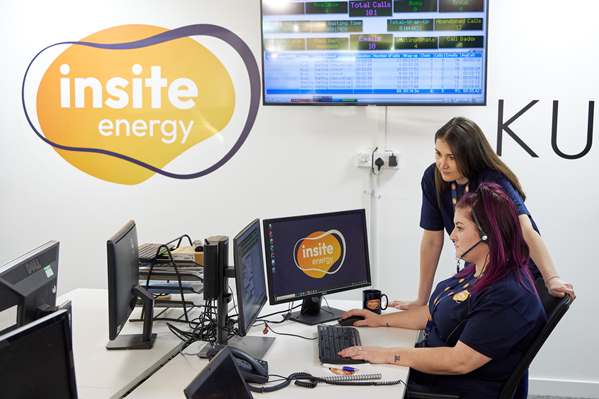
Carly Freeman, Head of Customer Services at Insite Energy, shares some key lessons learned while helping people at the sharp end of a crisis.
When times are hard for customers, high quality support is an absolute imperative. Nowhere is that truer than the energy sector, where soaring prices are causing financial stress for many, particularly since the price cap leapt up by 54% at the beginning of April.
For our service users who live in properties with communal heating systems (‘heat networks’), the situation is even more perilous, because they aren’t protected by a price cap and have no option to switch energy provider. As a result, some are facing kWh rate increases of almost 300%.
Companies across the energy sector should be stepping up their support in response to the cost-of-living crisis. However, a recent report from Citizens Advice shows that in fact most are allowing standards to fall as call-waiting times shoot up and websites crash under the strain.
It’s not good enough. When our customers reach out to us, we must ensure we’re there to help.
We can’t fix it, but we can listen
As a heat network metering and billing agent, it’s sadly not within our gift to reduce energy prices, although we are actively lobbying for the introduction of a price cap that applies to shared heating systems. In the meantime, we are doing our best to ensure the systems we have in place match our customers’ needs as closely as possible.
Here are some of the things we’ve learned about helping people at the sharp end of a crisis while also supporting and developing our team, and maintaining our reputation for outstanding customer service.
1. Be available
The number of queries we’re receiving relating to tariffs is the highest it’s ever been – 2022 figures are currently between five- and six-times higher than the previous year. It’s important that long waiting times don’t add to the stress and anxiety callers are already experiencing. We’ve done everything we can to make it quick and easy for residents to reach us by offering multiple contact routes including phone, email, and live webchat. We also have the longest contact-centre opening hours in our sector. As a result of these measures, our average call response times year-to-date have remained consistently at 1-minute 22-seconds, compared with 1-minute 21-seconds in 2021. In February, our monthly average dropped to 1-minute 8-seconds, and we remain second-best across the energy sector (gas and electricity included, based on Which? Autumn 2020 report) when it comes to response times.
2. Enable self-service
In 2019 we underwent a digital transformation that included the creation of a customer-centric website with access to comprehensive information and a host of accessible and easy-to-use self-serve online services. This has more than halved the volume of enquiries we received – from 103,000 in 2018 to 50,000 in 2021 – on issues such as moving in/out of properties and supply status on individual housing developments. Consequently, our seven-person customer team has much more time to devote to calls dealing with complex issues. The headcount is the same, but the depth, quality, and speed of the service they can now offer has greatly improved, with knock-on benefits for job satisfaction.
3. Empower staff with topical knowledge
The energy crisis is evolving quickly, and our team needs to be up-to-speed with the latest developments so they can inform customers confidently and accurately. We’ve introduced weekly training sessions on topics such as tariff changes and legal news.
4. Explain complex information
We keep updated tables with breakdowns of old and new energy tariffs on file to share with customers when needed. We can also create more detailed versions, including technical information, on request. Staff have been given specific training in how to explain these tables, so people understand what they’re looking at.
5. Share knowledge across teams
We hold regular knowledge-sharing sessions in which team leaders from across the business lead training for contact centre staff in different topics relating to heat network technology and the way our sector operates. This deepens the team’s understanding, enabling them to advise customers on things like optimising the efficiency of their heating system and reducing their energy usage.
6. Meet customers face to face
We always take the opportunity to go to in-person resident meetings. Combined with virtual meetings (which have grown in popularity following the pandemic) attendance at these sessions is currently the highest it’s ever been, and we’re fielding a lot of questions about tariffs and costs. Inviting feedback and using criticism to improve drives us forward. Customers see this and appreciate it too. We can’t reduce people’s bills but being present to listen to their concerns enables us to match our services to their requirements as closely as possible.
7. Acknowledge that it’s hard
During difficult periods, customer-experience professionals often bear the full brunt of people’s angst, adding to the stress of their jobs. Research recently released by the Institute of Customer Service suggests that 25% of customer-facing professionals expect customers to become more challenging over the next six months, with 66% highlighting the escalating cost of living crisis as a potential reason.
It’s important to acknowledge this and maintain an open team dialogue about what additional support is needed, ensuring those requirements are acted on quickly and effectively. We’ve gone to a great deal of effort to recruit and train excellent people, as well as put measures in place to take action quickly when things take a difficult turn – such as those outlined in the Institute of Customer Service’s ‘Service with Respect’ campaign and our own internal policies. We want our team to enjoy their jobs and stay with us for the long term.
8. Cast your net wider
When fuel costs rise, the efficiency of a network makes a big difference to bills. We encourage and reward excellent customer service not only amongst our call centre team, but also among our engineering team carrying out in-property maintenance. There is always the potential for inconsistencies in customer experience in our industry – but it’s well worth working to eliminate this, so customers feel satisfied with every interaction.
The benefits
By following these steps at Insite Energy, we’ve been able to continue to meet our customers’ needs during a concerning time when they’ve needed more support from us than ever. We’ve achieved this without growing our team or lowering the quality of our service – we’re still the top-performing heat network billing provider on Trustpilot with an ‘Excellent’ rating of 4.7 stars.
What is even more important, however, is the fact that the morale of our customer service team remains high. They know they are doing important work and making a difference. We’re confident that together we’ve created the support our customers need to navigate through the difficult months of uncertainty ahead.
About the Author
 Carly Freeman is Head of Customer Services at Insite Energy. Insite Energy provides heat metering, billing and payment services to landlords operating heat networks, providing a help-desk for residents of around 28,000 UK properties.
Carly Freeman is Head of Customer Services at Insite Energy. Insite Energy provides heat metering, billing and payment services to landlords operating heat networks, providing a help-desk for residents of around 28,000 UK properties.




